A travelogue on Kolkata, the birthplace of Satyajit Ray
Here is my travelogue for Kolkata India, birthplace of Satyajit Ray, or the City of RAY-diance as I like to call it. First impressions of Kolkata: it is so green; it seems to be part of nature as well as a city. Later on we were to marvel at the sanctuaries built into trees (what are they called?) and the seamless integration of the rural with the cityscape.
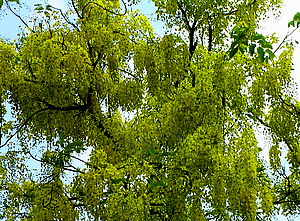
photo by mousourik We arrived at Netaji Subhash Bose a.k.a. Dum Dum airport, and it was immediately apparent that we were in a very polite and civilized place, as there was no pushing at the luggage arrival carrousel. A taxi had come to meet us as arranged and drive us to Sudder Street, which was very welcome after the long trip.
Anyway, we arrived at our hotel in the midst of chaotic traffic because the roads were being dug up. A blessing actually since the last few yards had to be taken on foot, meaning a lot less traffic noise. We were opposite the India museum and a stone’s throw away from New Market. All along Free School Street there were roadworks but the neighbourhood is friendly and welcoming.
Day One in Kolkata India
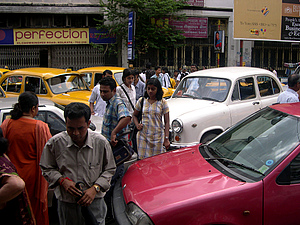
photo by Vishaka Our most urgent task was to secure the permits for Sikkim, so we headed off to Sikkim House on Middleton Street, where we were made very welcome. In fact (perhaps due to the recent bandh in the Hills as this was beginning of March of 2008), we were the only ones there! They asked for our itinerary and said come back in a couple of hours. We wanted to know where would be a good place for a chai, so they indicated the way to the "Punjabi Dhaba", a couple of blocks away. Indeed it was so delicious that we had two of them. Then back to Sikkim house where we took eager possession of our permits along with a couple of posters of orchids, advertising the Flower Festival.
Flushed with success, we sauntered over to Music World to look for DVDs of Satyajit Ray films. Again, a huge thank you to Jyoti, Brishti and Scandojazzbuff for all their help. We visited Flury’s and wondered at the Parisian ambiance in this Kolkattan institution. Fired up by excellent coffee, we decided spontaneously to head straight to the Book Fair in Salt Lake, even though we were supposed to be meeting up there with IndiaMikers on the following day - we are a disgrace - I know that Somnath has forgiven us. Anyhow, jetlag notwithstanding, taxi driver not having a clue how to get there and shouting at us (?) for not knowing the way, we made it in one piece to the Book Fair. It was great! We had a wonderful day.
Day Two in Kolkata India
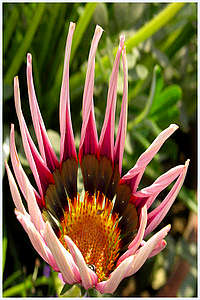
photo by Indranil_Dutta We woke up bright and early (TOO bright and TOO early), and some traders on the pavement next to the Maidan asked me "Why so happy Madam?". We tried to walk in the park at Eden Gardens while waiting for the museum to open, but were told by the wardens that it was shut. And then we visited the Museum. After asking the curator for permission we were allowed to view the "Buddha Bones" kept under lock and key. It was impressive. I particularly liked the anthropological section where you could see different parts of the Seven Sisters and the tribal folks of the North East with their regional costumes and artefacts. We met some girls who are students of anthropology at the University of Kolkata and chatted a while.
Later we took a cab to visit the Jain Temple, Sheetalnathji Mandir, also known as the Palace of Jewels, built in 1867, as well as the adjacent Jain Temple, Dadaji Jain Mandir, built in 1810. They are exquisite.
I was so overawed by the beauty that I left my camera (an old autofocus) on a bench in the garden. Returning with the same cab to Sudder Street, about 20 minutes into the journey, I reached for my camera to take a picture, and realizing I had mislaid it, we returned... it was still on the bench! Talk about good karma!
That evening we enjoyed the mouth-watering Bengali cuisine.
Day Three in Kolkata India
I call this the "Great B.B.D. Bagh Adventure" since we spent absolutely ages looking for the Black Hole of Calcutta and other landmarks such as the Tank. We couldn’t understand any of our maps (we had at least 3). At some point we asked a group of young men, “Which way is it to BBD /Dalhousie Square?”. One pointed left, one pointed right, the other pointed straight on. It was very funny.
The bottom line is that (in my blinkered English way) I was expecting something like a London square, not a pond of water! Well, you live and learn. If I were to do it again, I would take a guided tour because I think we were so busy trying to understand where we were going that we saw nothing.
The street with the typewriters was fascinating. I had also purchased "Ten Walks in Calcutta" which is a great book but so hard to follow when you have a million people trying to sell you:
- umbrellas (sun parasols?);
- gentleman’s underwear;
- bangles;
- school books;
- T-shirts and salwar kameez;
- plastic kitchenware etc. etc.
On top of that you are trying hard not to step on the produce on the pavement while crooking your neck upwards to read the non-existent street sign, which even if you could read it is different to the name on the map which dates from the previous century...!
Recovery came in the welcome form of coffee at Barista on Park Street. Then we visited the Nagaland Emporium and admired the stripey blankets. The Crossword Bookshop was OK but not as good as the Oxford Bookshop.
After a hard day’s sightseeing we popped into the Fairlawn for a Kingfisher and regretted that the next day we were leaving for Darjeeling, having been beguiled by Kolkata.
Day Four in Kolkata India
Following our wonderful interlude in Darjeeling/Sikkim we returned on the day of Holi to Kolkata.
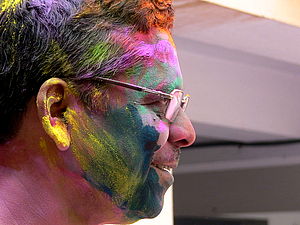
photo by chief61 We were hiding indoors so as not to get hit with paint, then belatedly realized that Holi had been yesterday, when we were travelling down from Bagdogra. We had wondered why the roads from the airport were so empty... actually, we saw masses of coloured faces with purple, pink, green, yellow paints, and thought it had all started a bit early.
So, we ventured out, noticing how many people had unsuccessfully tried to rid themselves of the coloured powders!
Our visit to the Tagore Museum in Kolkata India
This is an oasis of calm in the chaos of Kolkata. The former family home of Tagore on Rabindra Sarani, ex Chitpur Street, is fascinating. Afterwards we walked the length of Chitpur through the souk of perfume sellers, fruit wallahs, etc. It started to rain, so we took refuge in a coffee shop.
Day Five in Kolkata India
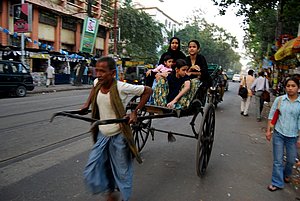
photo by India Edge We had our first and last experience of a hand-pulled rickshaw. We had great views of the street, but we feeling too sorry for the rickshaw-wallah. We got a little confused looking for it, but finally found the Indian Coffee House near the book stalls. It’s a great place to while away an hour or two. We started to feel like real Kolkata inhabitants!
Then we tried to follow the "Ten Walks in Calcutta" book to seek out some of the architectural marvels of the area. We chatted with an informative and interesting gentleman, but failed to find anything mentioned in the book. It was also very difficult to locate the Asutosh Museum, but it was well worth it. We were the only visitors and spent several hours there.
Last evening in town: the high life at Peter Cat for Chelo Kebabs.
The places I failed to see that I would visit next time around:
- Obviously, Kalighat. Hopefully without a severe attack of agoraphobia (joke).
- The flower markets, the Hooghly bridge.
- The New Market (we just ran through it, trying to avoid the eyes of the touts).
- Tollywood!
- The Park Street cemetery.
Actually, all the walks in "Ten Walks".
Original Link
http://www.indiamike.com/india-articles/a-travelogue-on-the-kolkata-india-the-birthplace-of-satyajit-ray/
![snake-person01 snake-person01 Grown Woman Eaten by Python [Very Graphic] picture](http://www.weirdasianews.com/wp-content/uploads/2008/10/snake-person01.jpg)
![snake-person02 snake-person02-150x150 Grown Woman Eaten by Python [Very Graphic] picture](http://www.weirdasianews.com/wp-content/uploads/2008/10/snake-person02-150x150.jpg)
![snake-person03 snake-person03-150x150 Grown Woman Eaten by Python [Very Graphic] picture](http://www.weirdasianews.com/wp-content/uploads/2008/10/snake-person03-150x150.jpg)
















 In order to have compassion for others, we have to have compassion for ourselves.
In order to have compassion for others, we have to have compassion for ourselves.